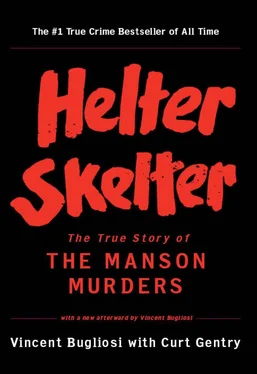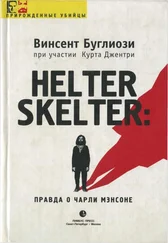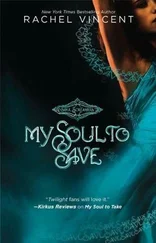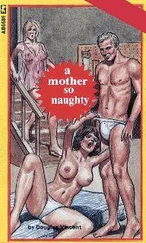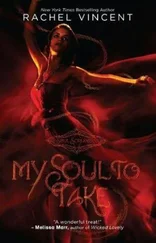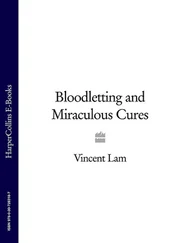In the twenty-five years since the murders, no event thrust the Manson Family back into the news once again as much as Lynette “Squeaky” Fromme’s attempted assassination of President Gerald Ford in 1975. After Manson was transferred from San Quentin back to Folsom in October of 1974, Squeaky and Sandra Good moved to Sacramento (fifteen miles to the west) to be as close to him as possible. [98] Though Squeaky and Sandra were not allowed to visit or even correspond with Manson, a prison spokesman at the time said that the two of them would come to the prison about once a month “to inquire about how Manson was doing.” A friend of Squeaky and Sandra told Time magazine that the girls believed Manson’s imprisonment was part of a grand design, “that he would rise again some day, like Christ. They spend all their time preparing themselves for the day he rises.”
Squeaky, Sandra, and a part-time nurse they had recruited into the Family named Susan Murphy, rented a run-down attic apartment in an old, downtown boardinghouse just a few blocks from the state capitol. On the sunny and crisp morning of September 5, 1975, President Ford was walking through a park in front of the capitol to meet Governor Jerry Brown.
Not only wasn’t Squeaky on the Secret Service’s list of dangerous people in town to watch—particularly remarkable when weeks earlier she and Sandra had issued a communiqué to the media in Sacramento that “if Nixon’s reality wearing a new face [i.e., Ford] continues to run this country against the law, your homes will be bloodier than the Tate-LaBianca homes and My Lai put together” [99] The Manson Family’s hatred of former President Nixon stems, of course, from Nixon’s headline-capturing declaration during the trial that he believed Manson to be guilty. In author Ed Sander’s best-selling book, The Family , he quotes a Manson therapist at Vacaville as saying Manson believed his own personal hex on Nixon had caused him to fall.
—but the President’s men inexplicably paid no attention to an elfish woman nearby attired in a bright red robe and matching turban. As Ford stopped at a magnolia tree to shake hands with a cluster of smiling supporters, Squeaky materialized out of the group, grabbed a gun from under her robe and pointed it at Ford, just two feet away. Instantly, Secret Service agent Larry Buendorf seized Squeaky’s gun arm and threw her to the ground. In apparent anger, Squeaky cried out, “It didn’t go off. Can you believe it? It didn’t go off.” The reason it didn’t go off will probably never be known beyond all doubt. To be sure, Squeaky’s .45 caliber Army Colt pistol, though loaded with four bullets, had no bullet in the chamber ready to be fired. To fire the gun, Squeaky would have first had to pull the slide back on top of the gun to raise a cartridge from the magazine into the firing chamber, which she hadn’t done. Had Squeaky mistakenly thought that squeezing the trigger (Buendorf and another witness reported hearing a metallic clicking sound, which could have been the hammer striking the rear of the firing pin) would be enough to fire the weapon? Because of the belief that Squeaky knew how to operate guns (on the documentary Manson she is seen operating the bolt of a rifle), many people, including some in law enforcement, are convinced she had no intention of hurting Ford. Nevertheless, prosecutor Dwayne Keyes, now a Superior Court judge in Fresno, told me he is “absolutely positive she had every intent to kill the President,” a state of mind the prosecution had to prove to secure a conviction.
In any event, Squeaky was now competing for the limelight, at least for a while, with her God, Charlie, making the September 15, 1975, covers of Newsweek and Time magazines. At her federal trial she was so obstreperous the judge had her removed from the courtroom for most of the proceedings, but not before she told him that one of the issues at the trial “was as clear as the piano in the front window of your home,” an accurate reference. During jury deliberations after a three-week trial in which Squeaky did not testify, “a lot of people,” juror Robert Convoy recalled, “believed that with no cartridge in the chamber, the gun wasn’t a weapon.” Ultimately, however, the jury found Squeaky guilty of attempting to assassinate Ford (prior to 1965, presidential assassination was only a state, not a federal, crime), the first female in American history so charged and convicted. Squeaky was sentenced to life imprisonment.
Was Manson behind the attempt? My instincts from the beginning were that he was not. Though Manson always spoke as if he had no fear of death, telling his followers that death wasn’t the end of life, “just another high,” even beautiful (“Living is what scares me. Dying is easy,” he’d also say, as well as implying he had been resurrected), I saw firsthand how hard he in fact fought for his life during his nine and one-half month trial. Having his death sentence removed just three years earlier, it made no sense to me that he would risk a new sentence of death against someone as remote to him and his interests as Ford. Prosecutor Keyes also believes that Manson was not involved, and his office found no evidence implicating him. Squeaky, the Little Orphan Annie-looking matriarch of the Family during Manson’s forced exile, was probably trying to impress Manson by her act. She had to know that successful or not in killing Ford, such a spectacular, grandly anti-societal act would be sure to please him.
Searching Squeaky’s apartment pursuant to a warrant after the attempt on Ford, police found a stack of letters, ready to go, from “The International People’s Court of Retribution,” an impressive-sounding organization whose membership, however, was rather limited—Squeaky, Sandra Good, and Susan Murphy. The letters threatened named corporate executives and U.S. government officials with death if they did not forthwith stop polluting the air and water and destroying the environment. A long list of other addressees was nearby. While on bail after her and Murphy’s arrest for conspiring to send threatening communications through the United States mail, Good proceeded to utter, on radio and TV, the same threats, constituting four new federal violations of transmitting death threats by way of interstate commerce.
Good represented herself at her trial, was convicted on all five counts (Murphy on only the conspiracy count), and asked that she be sentenced to the maximum of twenty-five years. The judge gave her fifteen. William Shubb, her appointed “advisory counsel” during the trial and now a U.S. Federal District Court judge in Sacramento, says that if she had been agreeable he is certain a plea could have been negotiated wherein her sentence would have been much less severe.
All of Manson’s co-defendants in the Tate-LaBianca murders are, like Manson, still behind bars serving their life sentences.
Charles “Tex” Watson, Manson’s chief lieutenant at the murder scenes and the principal killer of the Tate-LaBianca victims, has renounced Manson and is presently at Mule Creek State Prison in Ione, California. He was transferred there in April of 1993 from the California Men’s Colony (CMC) in San Luis Obispo, where he had been incarcerated since September 1972. At CMC in 1975, Watson, through the ministry of Raymond Hoekstra (a legendary prison evangelist known as “Chaplain Ray”), became a born-again Christian. As a student chaplain and associate administrator of the Protestant chapel at CMC, Watson baptized, led Bible-study groups, and preached to the inmate congregation. In 1980, Watson founded Abounding Love Ministries (ALMS), a California nonprofit corporation which he and his Norwegian wife, Kristin, run. The two married in 1979 and have three children. Ordained as a minister in 1983, Watson receives donations to his ministry of approximately $1,500 per month from people on a national mailing list to whom he sends religious cassette tapes and a Christian newsletter.
Читать дальше
